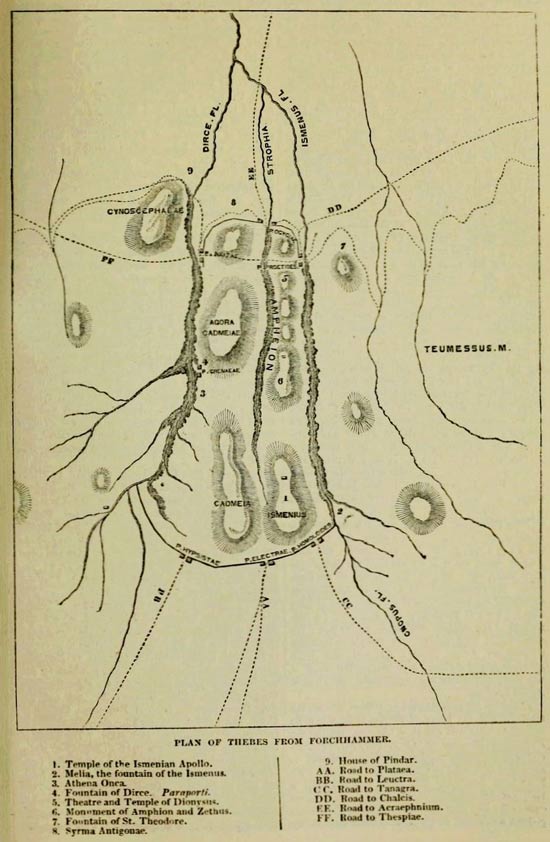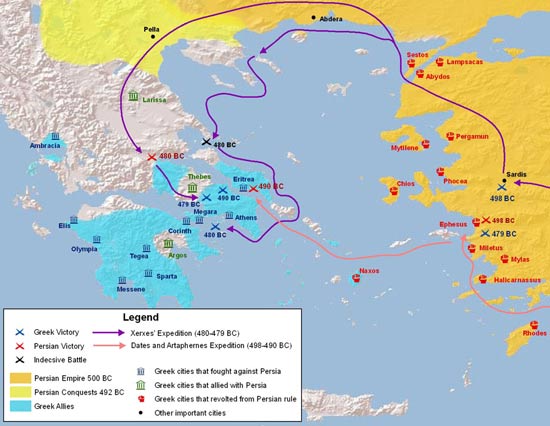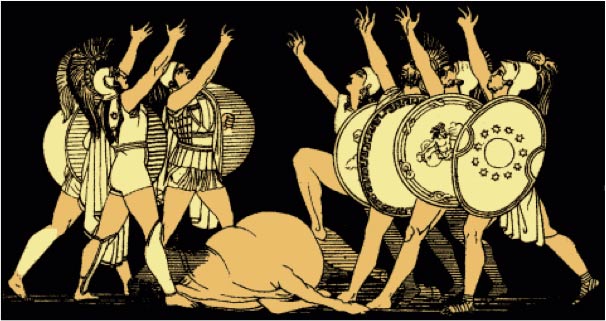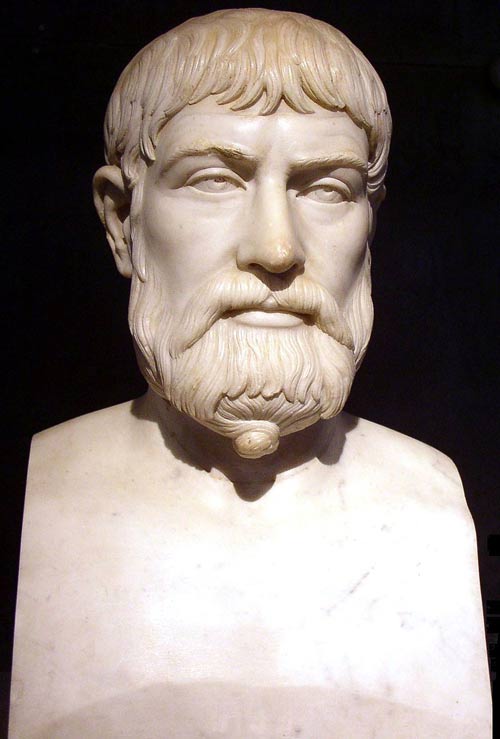By Jocelyn Hitchcock, Contributing Writer, Classical Wisdom
Having been inhabited for roughly 5,000 years, Thebes possesses a wealth of history and culture. Thebes is located in central Greece and garnered military might and political power, not least of which resulted from their leadership in the Boeotian League and the Sacred Band of soldiers in the 4th century.

Plan of Thebes
Archaeological excavations have revealed fortified buildings with rock-cut foundations as well as courtyards (stone-paved) and mud brick walls dating back to the 3rd millennium BC. Around 2500 BC, we see evidence for food and wool production and trade, thanks to recovered grinding stones and terracotta loom weights and spools.
Jumping ahead to the Mycenaean period, Thebes boasted a Mycenaean palace called Kadmeion, located in the center of the acropolis. It was a large independent structure comprised of corridors, rooms for work and storage, as well as workshops that were vital to the existence of Thebes. Also found were Linear B tablets and seal stones, along with Cretan stirrup jars, that demonstrate that Thebes had widespread contacts in the Aegean. While the trade alone is not surprising for this time period, it does help us understand the role and significance Thebes played early on.

The Mycenaean Palace, or Kadmeion, dates from the 13th century BC and is located almost centrally on the acropolis.
Around 1200 BC the Mediterranean was swallowed up in a relatively indecipherable fog… however, Thebes emerged again in the Archaic period with infrastructure and power. Soon, they forged an antagonistic relationship against Athens and Sparta, fighting almost constantly for regional dominance. It didn’t help Thebes’ image throughout Greece either that they sided with Persia and Xerxes in 480 BC during the Persian War.
After the Persian War, there was relative quiet, save for the rising tensions among the Greek powers themselves. Thebes needed to be punished for their alliance with the Persians, and so was stripped of the head seat at the Boeotian league.

Historical Atlas of the Mediterranean/Persian Wars
However, not soon after, Sparta needed support against Athens in central Greece and enlisted Thebes to take up the position. By 431 BC, there was an all out war (the Archidamian War) between allies Sparta, Corinth, and Thebes against Athens which lasted until 421 BC. After the Archidamian War, there was the Decelean War (415 BC -404 BC) and the Corinthian War (395 BC – 387 BC, Thebes Corinth, Argos, and Athens against Sparta).
Turmoil abounded (with Thebes often highly involved) until the invasion of Philip of Macedonia. In 338 BC, Thebes joined Athens and Corinth, setting aside a rivalry going back hundreds of years in order to stand against the Macedonians. We all know the result; eventually Thebes was destroyed by Alexander the Great and the population was sold into slavery.
The subsequent years saw Roman visits and rebuilding, population depletion, and finally becoming a provincial town in the Roman Empire. The zenith of Thebes had come to an end long before, though its mythology still lives on.
Mythology in Thebes

The Seven Against Thebes
Like most Greek cities, Thebes has a foundation myth that connects its people to the gods. In the case of Thebes, it was founded by Kadmos (or Cadmus), son of Egenor and brother of Europa. While specifics change depending on who is reporting the story, the basics remain that Kadmos was to sow the teeth of a giant serpent (that he had previously slain) into the ground. From this spot a group of warriors sprang from the earth, and they fought and battled to found the city of Kadmea.
Another prominent myth, that again has to do with a psuedo-foundation, is Seven Against Thebes. In this story, Oedipus’ two sons, Polyneikes and Eteokles, embroiled themselves in a war. After Eteokles exiled Polyneikes, he enlisted the help of the Achaeans to take back the city of Thebes. Seven warriors, including Polyneikes, started their assault on the city and began scaling the walls. Even though six out of the seven were killed, the attack was successful and Polyneikes (though dead) took back the city from his brother.
Famous People from Thebes

Pindar, Roman copy of Greek 5th century BC bust (Museo Archeologico Nazionale, Naples)
Perhaps three of the most notorious people from Thebes are Epaminondas, Pelopidas, and Pindar.
Epaminondas (born around 418 BC and died 362 BC) was a military general and student of philosophy. He commanded the Theban forces at pivotal battles such as Leuctra, where the Thebans delivered such a decisive blow to the Spartans that a monument was erected, as well as the Battle of Mantinea where he died in battle.
At the same time as Epaminondas, Pelopidas campaigned in Central and Northern Greece, and died in the Battle of Cynoscephalae in 364 BC. He was successful in the battle though and overthrew the Thessalian troops of Alexander of Pherae.
However, the most recognizable celebrity to come from Thebes may certainly be Pindar, the poet of paeans, songs, and hymns. Though fragmentary, we do have 45 of his lyric odes, or epinicia, to honor notable people. Pindar authored a style that was mirrored by Latin poets, like Horace, and was popular material for Byzantine literature. In 1896, a “Pindaric Ode” was created for the Olympic Games in Athens, similarly copied as recently as 2012.
Contributions from Thebes
Among the literature, mythology, and fodder for excavation that Thebes has provided us, she also left behind a legacy of political contributions. In 378 BC, Thebes remodeled their constitution and established a democracy and the Boeotian federation. This new and somewhat radical type of “democratic Federalism” provided direct federal citizenship to those in her domain.
Another contribution Thebes provided is the so-called Theban “hegemony.” This was the period after the Theban victory at the battle of Leuctra, where for decades Thebes held powerful influence and loyalty in Greece, acquired not by military occupations but by lucrative alliances maintained throughout the region.
An, although mythic, Kadmus is credited with bringing the alphabet to Thebes from the east, a contribution that would have inhibited Theban growth in subsequent years.









No comments
Trackbacks
Our apologies, you must be logged in to post a comment.